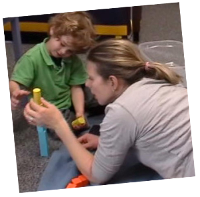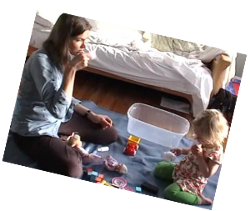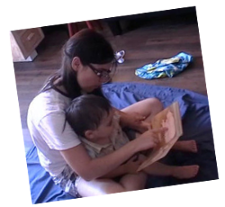Examining variability in language development
Parent-child interactions are the foundational forum for language exposure and learning.We know from a wealth of evidence that higher amounts of language input and varied forms of language input provided by parents to their young children during these interactions enhances language development in typical development, which in turn confers long-term linguistic and academic advantages (Hart & Risley, 1995; Hoff & Naigles, 2002; Huttenlocher et al., 1991; Hurtado et al., 2008). These findings reveal that children implicitly keep track of language input, and develop better language abilities when immersed in rich input environments.
There has been less attention paid to the role of parental linguistic input in language development in children on the autism spectrum. A clearer picture of the data that children on the spectrum have available to mine for language learning, as well as of specific relationships between aspects of the input and later language development, are essential for a comprehensive view of factors that contribute to language development in this population.
Our findings, culled from transcription of naturalistic parent-child play interactions, demonstrate that parents of children on the autism spectrum provide similar linguistic environments for their children as do parents of typically-developing children of the same language ability. However, this generally happens at a later chronological age, due to the language delays that are common amongst children on the autism spectrum. Critically, we found that a rich and varied linguistic environment helps children on the autism spectrum build their later vocabulary, as is the case for other children. These findings highlight the key role caregivers and educators can have in the language development of children on the autism spectrum In addition, they have significant implications for intervention approaches to facilitate language development, supporting the use of full and complex rather than simplified language.
Additionally, we have been studying how basic cognitive skills contribute to variation in children’s language learning. For instance, we have examined situations where new vocabulary is taught explicitly, and children’s ability to use social vs. non-social cues to learn these new words, and to retain them over time. We have also investigated implicit learning situations: whether children are able to pick up on patterns that are not taught directly (i.e., procedural learning of a visual sequence), and how this relates to their language skills. In other studies we have examined memory for speech sounds, through tasks where children are asked to repeat nonsense or “non-words”, and how this may relate to their ability to learn language, and how it may differ across populations. Together these findings give insight into multiple sources of variability in language learning that arise from basic cognitive mechanisms.



Publications on Parent interaction and child language development
Journal Articles
- Glick, A. R., Saiyed, F. S., Kutlesa, K., Onishi, K. H., & Nadig, A. S. (2022). Implications of video chat use for young children's learning and social-emotional development: Learning words, taking turns, and fostering familial relationships. Wiley interdisciplinary reviews. Cognitive science, 13(5), e1599. https://doi.org/10.1002/wcs.1599
- Rvachew, S., Rees, K., Carolan, E. & Nadig, A. (2017). Improving emergent literacy with school-based shared reading: Paper versus eBooks. International Journal of Child-Computer Interaction, 12, 24-29. https://doi.org/10.1016/j.ijcci.2017.01.002
- Rees, K., Rvachew, S. & Nadig, A. (2017). Story-related discourse by parent-child dyads: A comparison of typically developing children and children with language impairments. International Journal of Child-Computer Interaction, 12, 16-23. https://doi.org/10.1016/j.ijcci.2017.01.001
- Bang, J. & Nadig, A. (2015). Learning Language in Autism: Maternal Linguistic Input Contributes to Later Vocabulary, Autism Research, 8 (2), 214-223. https://doi.org/10.1002/aur.1440
- Nadig, A., Ozonoff, S., Young, G., Rozga, A., Sigman, M., & Rogers, S. J. (2007). A prospective study of response-to-name in infants at risk for autism. Archives of Pediatrics and Adolescent Medicine, Theme issue on Autism, 161 (4), 378-383.
Book Chapters
- Nadig, A. & Bang, J. (2017). Parental input to children with ASD and its influence on later language. In L. Naigles (Ed.), Language and the human lifespan series. Innovative investigations of language in autism spectrum disorder (p. 89- 113). American Psychological Association; Walter de Gruyter. https://doi.org/10.1037/15964-006
- Rees., K., Rvachew, S. & Nadig, A. (2016). Adults and children make meaning together with e-books. In N. Kucirkova and G. Galloon (Eds.), Apps, technology and young learners: International evidence for teaching. Taylor &Francis/Routledge.
Publications on Mechanisms of language learning
Journal Articles
- Bang, J. Y., Sharda, M., & Nadig, A. S. (2020). Towards greater transparency in neurodevelopmental disorders research: use of a proposed workflow and propensity scores to facilitate selection of matched groups. Journal of Neurodevelopmental Disorders, 12(1), 1-15. https://doi.org/10.1186/s11689-020-09321-6
- Bang, J. Y., & Nadig, A. (2020). An investigation of word learning in the presence of gaze: Evidence from school-age children with typical development or Autism Spectrum Disorder. Cognitive Development, 54, 100847. https://doi.org/10.1016/j.cogdev.2020.100847
- Eberhardt, M. & Nadig, A. (2018). Reduced sensitivity to context in language comprehension: A characteristic of Autism Spectrum Disorders or of poor structural language abilities? Research in Developmental Disabilities, 72, 284-296. http://dx.doi.org/10.1016/j.ridd.2016.01.017
- Nadig, A. & Mulligan, A. (2017). Intact non-word repetition and similar error patterns in language-matched children with autism spectrum disorders: A pilot study. Journal of Communication Disorders, 66, 13-21. https://doi.org/10.1016/j.jcomdis.2017.03.003
- Bani Hani, H., Gonzalez-Barrero, A. & Nadig, A. (2013). Children’s referential understanding of novel words and parent labelling behaviours: similarities across children with and without autism spectrum disorders. Journal of Child Language, 40 (5), 971-1002. https://doi.org/10.1017/S0305000912000426
- Bourguignon, N., Nadig, A. & Valois, D. (2012). The Biolinguistics of Autism: Emergent Perspectives. Biolinguistics, 6 (2), 124-165. http://biolinguistics.eu/index.php/biolinguistics/article/view/234
- Vivanti, G., Nadig, A., Ozonoff, S., & Rogers, S.J. (2008). What do children with autism attend to during imitation tasks? Journal of Experimental Child Psychology, Special issue on Imitation in Autism, 101, 186-205.
- Nadig, A., Ozonoff, S., Singh, L., Young, G., & Rogers, S. J. (2007). Do 6-month-old infants at risk for autism display an infant-directed speech preference? In H. Caunt-Nulton, S. Kulatikake, & I. Woo (Eds.), Proceedings of the 31st Annual Boston University Conference on Language Development (451-461). Somerville, MA: Cascadilla Press.
Selected Conference Presentations
- Goad, H., Li, F., Gonzalez Barrero, A.M. & Nadig, A. (2019, May). Phonological Factors Underlying Performance on a Multi-Lingual Non-Word Repetition Task. Poster presented at the annual meeting of the International Society for Autism Research, Montreal, Canada.
- Li, F., Gonzalez Barrero, A.M. Goad, H., & Nadig, A. (2019, May). Evaluation of a Novel Non-Word Repetition Test As a Clinical Marker for Language Impairment in Multilingually-Exposed Children with ASD. Poster presented at the annual meeting of the International Society for Autism Research, Montreal, Canada.
